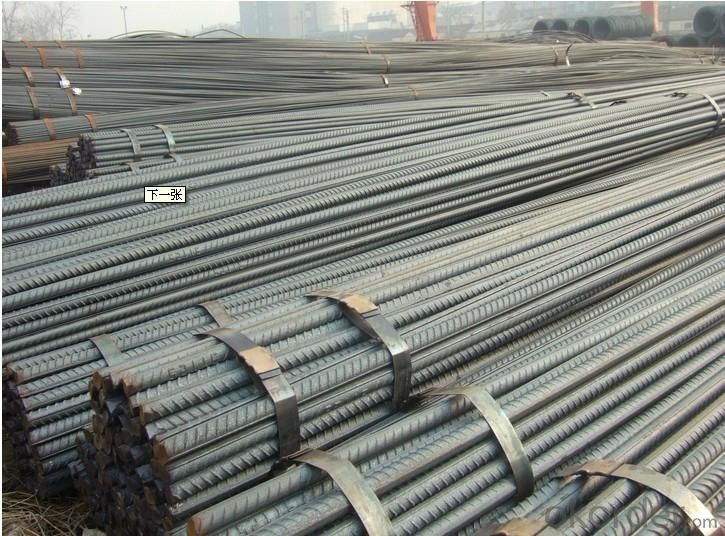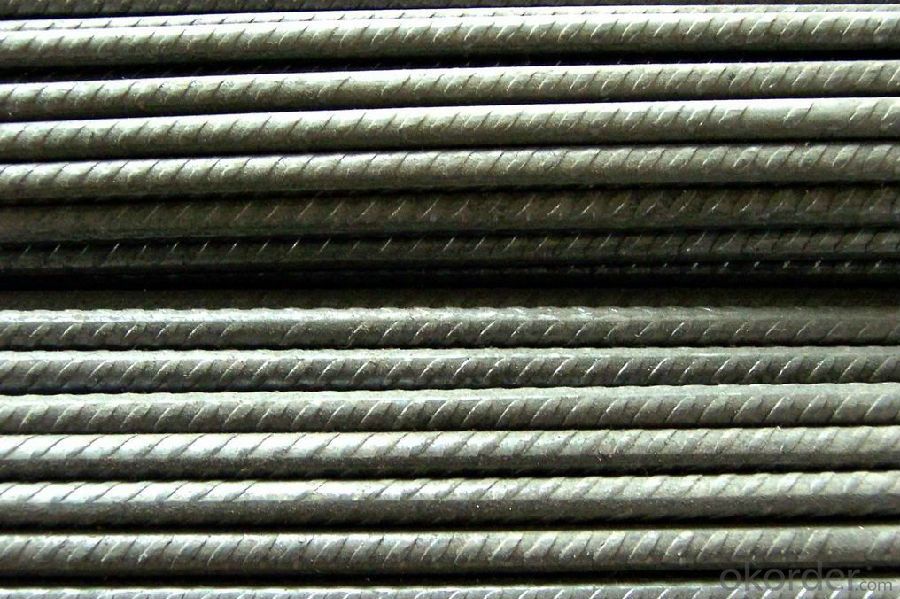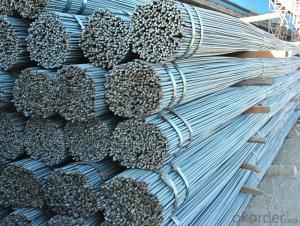Hot Rolled Deformed Bar HRB400 or BS449 B500B
- Loading Port:
- Tianjin
- Payment Terms:
- TT OR LC
- Min Order Qty:
- 25 m.t.
- Supply Capability:
- 200000 m.t./month
OKorder Service Pledge
OKorder Financial Service
You Might Also Like
Product Description:
OKorder is offering Product Description:
OKorder is offering Hot Rolled Deformed Bar HRB400 or BS449 B500B at great prices with worldwide shipping. Our supplier is a world-class manufacturer of steel, with our products utilized the world over. OKorder annually supplies products to European, North American and Asian markets. We provide quotations within 24 hours of receiving an inquiry and guarantee competitive prices.
Product Applications:
Deformed bar is widely used in buildings, bridges, roads and other engineering construction. Big to highways, railways, bridges, culverts, tunnels, public facilities such as flood control, dam, small to housing construction, beam, column, wall and the foundation of the plate, deformed bar is an integral structure material. With the development of world economy and the vigorous development of infrastructure construction, real estate, the demand for deformed bar will be larger and larger
Product Advantages:
OKorder's Hot Rolled Deformed Bar HRB400 or BS449 B500B are durable, strong, and resist corrosion, exact size, regular package, chemical and mechanical properties are stable.
Main Product Features:
· Premium quality
· Prompt delivery & seaworthy packing (30 days after receiving deposit)
· Corrosion resistance
· Can be recycled and reused
· Mill test certification
· Professional Service
· Competitive pricing
Product Specifications:
Manufacture: Hot rolled
Grade: BS4449
Certificates: ISO, SGS, BV, CIQ
Diameter: 6mm,8mm,10mm,12mm,14mm,16mm,18mm,20mm,
22mm,25mm,28mm,32mm,36mm,40mm,50mm
Length: 6M, 9M,12M or as required
Packaging: Export packing, nude packing, bundled
Chemical Composition: (Please kindly find our chemistry of our material based on HRB500 as below for your information)
Grade | Technical data of the original chemical composition (%) | ||||||
C | Mn | Si | S | P | V | ||
HRB400 | ≤0.25 | ≤1.60 | ≤0.80 | ≤0.045 | ≤0.045 | 0.04-0.12 | |
Physical capability | |||||||
Yield Strength (N/cm²) | Tensile Strength (N/cm²) | Elongation (%) | |||||
≥400 | ≥570 | ≥14 | |||||
Theoretical weight and section area of each diameter as below for your information:
Diameter(mm) | Section area (mm²) | Mass(kg/m) | Weight of 12m bar(kg) |
6 | 28.27 | 0.222 | 2.664 |
8 | 50.27 | 0.395 | 4.74 |
10 | 78.54 | 0.617 | 7.404 |
12 | 113.1 | 0.888 | 10.656 |
14 | 153.9 | 1.21 | 14.52 |
16 | 201.1 | 1.58 | 18.96 |
18 | 254.5 | 2.00 | 24 |
20 | 314.2 | 2.47 | 29.64 |
22 | 380.1 | 2.98 | 35.76 |
25 | 490.9 | 3.85 | 46.2 |
28 | 615.8 | 4.83 | 57.96 |
32 | 804.2 | 6.31 | 75.72 |
36 | 1018 | 7.99 | 98.88 |
40 | 1257 | 9.87 | 118.44 |
50 | 1964 | 15.42 | 185.04 |
FAQ:
Q1: How do we guarantee the quality of our products?
A1: We have established an advanced quality management system which conducts strict quality tests at every step, from raw materials to the final product. At the same time, we provide extensive follow-up service assurances as required.
Q2: What makes stainless steel stainless?
Within three days of placing an order, we will begin production. The specific shipping date is dependent upon international and government factors, but is typically 7 to 10 workdays.
Q3: What makes stainless steel stainless?
A3: Stainless steel must contain at least 10.5 % chromium. It is this element that reacts with the oxygen in the air to form a complex chrome-oxide surface layer that is invisible but strong enough to prevent further oxygen from "staining" (rusting) the surface. Higher levels of chromium and the addition of other alloying elements such as nickel and molybdenum enhance this surface layer and improve the corrosion resistance of the stainless material.


- Q:Can steel rebars be used in tunnels and underground structures?
- Yes, steel rebars can be used in tunnels and underground structures. Rebars are commonly used in construction projects to reinforce concrete structures and provide additional strength and durability. In tunnels and underground structures, where stability and load-bearing capacity are crucial, steel rebars are often incorporated into the concrete walls, floors, and ceilings to enhance their structural integrity. The rebars help to distribute the load and resist potential cracks or deformations caused by the pressure from the surrounding soil or water. Moreover, steel rebars offer resistance against corrosion, making them suitable for underground environments where moisture and other corrosive elements may be present. Overall, steel rebars are an essential component in the construction of tunnels and underground structures, ensuring their safety and longevity.
- Q:What is the importance of proper alignment of steel rebars in a structure?
- The proper alignment of steel rebars in a structure is of utmost importance as it ensures the structural integrity and strength of the building. Rebars act as reinforcements, providing additional support to the concrete, preventing cracks and enhancing its load-bearing capacity. When properly aligned, rebars distribute the load evenly across the structure, reducing the risk of structural failure or collapse. Additionally, proper alignment allows for effective transfer of forces, improving the overall stability and durability of the building.
- Q:What are the alternatives to steel rebars in construction?
- Some alternatives to steel rebars in construction include fiber-reinforced polymer (FRP) rebars, carbon fiber-reinforced polymer (CFRP) rebars, and glass fiber-reinforced polymer (GFRP) rebars. These materials offer similar strength and durability to steel rebars while also providing benefits such as corrosion resistance, lighter weight, and ease of installation. Additionally, materials like bamboo, timber, and basalt rebars are being explored as sustainable alternatives to steel rebars in certain construction projects.
- Q:Can steel rebars be used in dams and reservoirs?
- Yes, steel rebars can be used in dams and reservoirs. Steel rebars are commonly used in the construction of dams and reservoirs to provide structural reinforcement and strength to the concrete structures. The rebars are embedded within the concrete to enhance its tensile strength and prevent cracks or failure.
- Q:What is the process of reinforcing existing concrete structures with steel rebars?
- The process of reinforcing existing concrete structures with steel rebars involves several steps. First, a structural assessment is conducted to determine the areas that require reinforcement. Once identified, the concrete surface is prepared by cleaning and removing any loose or deteriorated material. Next, the rebars are positioned and secured to the existing concrete using epoxy adhesive or mechanical anchors. These rebars are strategically placed to distribute and support the additional load. Finally, the rebars are encased in a new layer of concrete called shotcrete or sprayed concrete, which acts as a protective and bonding layer. The result is a strengthened and more durable concrete structure capable of withstanding increased loads and extending its lifespan.
- Q:How do steel rebars contribute to the fire resistance of concrete?
- Steel rebars contribute to the fire resistance of concrete by providing structural reinforcement. In the event of a fire, the rebars help to maintain the integrity and stability of the concrete structure, preventing it from collapsing or losing its load-bearing capacity. The steel rebars also act as a heat sink, absorbing and dissipating heat away from the concrete, thereby slowing down its temperature rise and reducing the risk of structural failure.
- Q:What are the guidelines for ensuring proper bond between steel rebars and concrete?
- Ensuring a strong bond between steel rebars and concrete is vital for the structural integrity and performance of reinforced concrete structures. To achieve this, the following guidelines should be followed: 1. Correct Placement of Rebars: The rebars must be positioned according to the design specifications, including the required spacing, cover, and lap lengths. It is important to maintain the appropriate spacing between rebars and the concrete surface to provide sufficient concrete cover and prevent corrosion. 2. Thorough Surface Preparation: The steel rebars should be free from loose rust, scale, or contaminants that could hinder the bond with the concrete. Effective surface preparation techniques such as wire brushing, sandblasting, or using a high-pressure water jet can be used to clean the rebars. 3. Mechanical Bond: Ribbed or deformed rebars offer a better mechanical bond with concrete compared to smooth bars. The surface deformations increase the contact area between the rebar and the concrete, thereby enhancing the bond strength. 4. Proper Embedment Length: The embedment length, also known as the development length, is the distance over which the rebar is embedded in the concrete. It is typically calculated based on the required bond strength, concrete strength, and rebar diameter. Adequate embedment length is essential for achieving the desired bond performance. 5. High-Quality Concrete: The quality of concrete, including its strength, workability, and curing, plays a crucial role in achieving a proper bond with steel rebars. The concrete mix should be proportioned correctly, ensuring sufficient cement content, appropriate water-to-cement ratio, and proper compaction during placement. 6. Sufficient Concrete Cover: Adequate concrete cover should be provided around the rebars to protect them from environmental factors, prevent corrosion, and ensure long-term durability. The concrete cover is typically specified in design codes and should be maintained during construction. 7. Proper Reinforcement Splicing: When connecting multiple rebars, proper splicing techniques should be used to ensure a continuous and strong bond. Lap splices, mechanical couplers, or welded splices can be employed based on the design requirements and project specifications. 8. Effective Vibration Techniques: During concrete placement, proper vibration techniques should be employed to ensure adequate compaction and minimize voids or honeycombs around the rebars. This helps to achieve a better bond between the steel rebars and the surrounding concrete. 9. Prevention of Contamination: The rebars should be protected from contamination during storage and construction. Exposure to excessive moisture, chemicals, or other corrosive substances can compromise the bond between the rebars and the concrete. 10. Adherence to Design Specifications: Lastly, it is crucial to strictly adhere to the design specifications and recommendations provided by structural engineers or relevant design codes. These guidelines are tailored to ensure a proper bond between steel rebars and concrete, considering factors such as loadings, environmental conditions, and durability requirements.
- Q:What is the maximum diameter of steel rebars used in residential construction?
- The maximum diameter of steel rebars used in residential construction typically ranges from 12 millimeters (0.47 inches) to 32 millimeters (1.26 inches).
- Q:How do steel rebars contribute to the structural soundness of a building?
- The construction industry heavily relies on steel rebars to ensure the structural integrity of buildings. These reinforcing bars, commonly referred to as rebars, are composed of steel and embedded within concrete to provide additional strength and reinforcement. One of the main ways in which steel rebars contribute to a building's structural soundness is by bolstering its tensile strength. Concrete is excellent at handling compressive forces but lacks strength when it comes to tension. Buildings are subjected to various loads, including wind, earthquakes, and their own weight, which exert both compressive and tensile forces. By incorporating steel rebars into the concrete, the overall structure's tensile strength is significantly improved. This prevents the concrete from cracking or failing under tension, guaranteeing the stability and durability of the building over time. Additionally, steel rebars enhance a building's ductility, which refers to its ability to deform under stress without breaking. Concrete, being a brittle material, lacks ductility and tends to fail suddenly when subjected to excessive stress. With the inclusion of steel rebars, the concrete-reinforced structure gains the capacity to absorb and distribute energy, allowing it to undergo controlled deformations without abrupt failure. This increased ductility ensures that the building can withstand dynamic loads, such as those generated during an earthquake, and reduces the risk of catastrophic collapse. In addition to improving tensile strength and ductility, steel rebars also contribute to the overall stability and load-bearing capacity of a building. By evenly distributing the load across the structure, they help minimize the concentration of stress in specific areas, thus preventing potential weak points or failure spots. This distributed load-bearing capacity ensures that the building can support its intended weight and endure the forces acting upon it. Furthermore, steel rebars play a crucial role in extending the lifespan of a building by offering protection against corrosion. Steel is prone to rust when exposed to moisture and air, which can compromise its structural integrity. However, rebars are often coated with epoxy or other anti-corrosion materials to prevent rusting. This protective layer ensures that the steel remains intact and maintains its strength over time, further bolstering the structural soundness of the building. To summarize, steel rebars are essential components in guaranteeing the structural soundness of buildings. They enhance concrete's tensile strength, improve its ductility, increase load-bearing capacity, and safeguard against corrosion. By incorporating steel rebars, buildings can withstand various loads, resist cracking, and ensure long-term stability and durability.
- Q:Are steel rebars easy to handle and install on-site?
- Yes, steel rebars are generally easy to handle and install on-site. They are lightweight, durable, and come in various lengths and sizes, making them convenient to work with. Additionally, their ribbed surface provides better adhesion with concrete, ensuring a secure installation.
1. Manufacturer Overview |
|
|---|---|
| Location | |
| Year Established | |
| Annual Output Value | |
| Main Markets | |
| Company Certifications | |
2. Manufacturer Certificates |
|
|---|---|
| a) Certification Name | |
| Range | |
| Reference | |
| Validity Period | |
3. Manufacturer Capability |
|
|---|---|
| a)Trade Capacity | |
| Nearest Port | |
| Export Percentage | |
| No.of Employees in Trade Department | |
| Language Spoken: | |
| b)Factory Information | |
| Factory Size: | |
| No. of Production Lines | |
| Contract Manufacturing | |
| Product Price Range | |
Send your message to us
Hot Rolled Deformed Bar HRB400 or BS449 B500B
- Loading Port:
- Tianjin
- Payment Terms:
- TT OR LC
- Min Order Qty:
- 25 m.t.
- Supply Capability:
- 200000 m.t./month
OKorder Service Pledge
OKorder Financial Service
Similar products
New products
Hot products
Related keywords




























